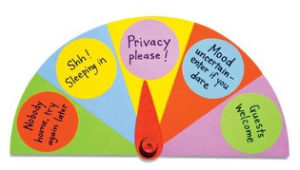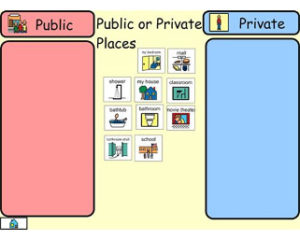Knowing the difference between public and private behaviours is an essential skill your child needs to learn in order to keep safe and participate in the community.
A quick and simple rule to help your child learn this is:
“Private behaviours involve private body parts and can only be done in a private place.”
Read more about private parts here and private places here
What are the private behaviours?
Can I do all of the private behaviours in private places?
Private behaviours can include:
- going to the toilet
- showering/bathing
- getting changed
- touching private body parts
- masturbating
- having sex
There are some places that can be a bit confusing for children when talking about private behaviours.
- Public toilets and change rooms
- Shared bedrooms
- scheduled for a particular time of day or signalled with a sign on the door
- evenly allocated between room occupants to make sure your child isn’t constantly in the private place reducing access for others
- redirected to the toilet or bathroom if the room is occupied by another person
What are the private behaviours?
Private behaviours can include:
- going to the toilet
- showering/bathing
- getting changed
- touching private body parts
- masturbating
- having sex
Can I do all of the private behaviours in private places?
There are some places that can be a bit confusing for children when talking about private behaviours.
- Public toilets and change rooms
- Shared bedrooms
- scheduled for a particular time of day or signalled with a sign on the door
- evenly allocated between room occupants to make sure your child isn’t constantly in the private place reducing access for others
- redirected to the toilet or bathroom if the room is occupied by another person
Conversation Starters
Touching your own body can feel really nice! I feel good when I brush my hair. What makes you feel nice?
It can feel nice to touch our private parts, but it’s important to make sure you are in a private when you are touching your private body parts. Can you tell me/show me where your private place is?
When you go to your room for private time, can you tell me/show me what you need to do to get ready? (Answer should be along the lines of closing the door, closing the curtain, signage, etc.)
Strategies for you to try
Create a private place sign
Signs are a useful way to help your child identify when they want private time to do private behaviours. You can create a “PRIVATE PLACE” sign for: • the toilet • the bathroom • your child’s bedroom Here is an example of a sign that was made for a bedroom. You can also use the resources below to help your child understand where private parts, places and behaviours come together. Resources like social stories are useful as they help blend individual concepts into a real life situation.
You can also use the resources below to help your child understand where private parts, places and behaviours come together. Resources like social stories are useful as they help blend individual concepts into a real life situation.
Use games or images to practice categorising private behaviours with the appropriate private place
 You can also print out photos of places in your everyday life and use them to reinforce the differences between public and private places. Ask your child where they think certain behaviours should happen and use photos to redirect them to a private place when needed.
You can also print out photos of places in your everyday life and use them to reinforce the differences between public and private places. Ask your child where they think certain behaviours should happen and use photos to redirect them to a private place when needed.



